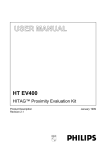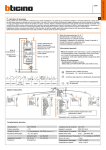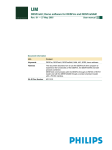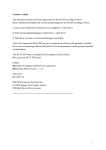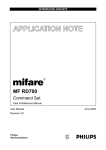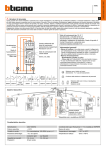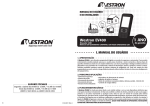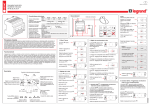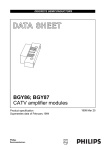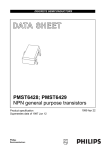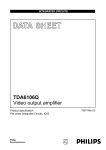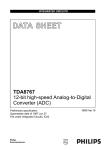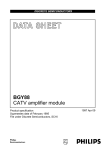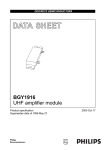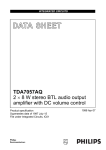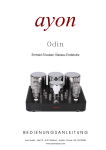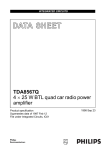Download AN065010 - NXP Semiconductors
Transcript
READER COMPONENTS SL EV400 Quick Introduction Sheet Preliminary Specification Revision 1.0 Philips Semiconductors November 2001 Philips Semiconductors Preliminary Specification Rev. 1.0 November 2001 Quick Introduction Sheet SL EV400 CONTENTS 1 GENERAL INFORMATION 3 1.1 Scope 3 1.2 General Description 3 1.3 System Requirements 4 1.4 Getting started 5 1.4.1 USB driver Installation 5 1.4.2 Exploring the CD 12 2 CONTENT OF THE PEGODA CD 13 3 GENERAL CONDITIONS 14 3.1 Usage 14 3.2 The AS IS paragraphs 14 3.3 USB Driver 14 4 COPYRIGHTS 15 5 REVISION HISTORY 16 2 Philips Semiconductors Preliminary Specification Rev. 1.0 November 2001 Quick Introduction Sheet SL EV400 1 GENERAL INFORMATION 1.1 Scope This document describes how to get started with PHILIPS I•CODE Pegoda SL EV400. This is the evaluation kit of PHILIPS reader IC SL RC400. The SL RC400 is member of a new family for highly integrated reader ICs for contactless communication at 13.56 MHz. This family is called MICORE. The content of the I•CODE Pegoda CDROM should help the user to design in the SL RC400 in a specific application or to design a new read/write device taking the I•CODE Pegoda as a reference design. The following description covers how to set-up the needed driver to start the I•CODE Pegoda evaluation kit and should give an overview about the added documents and software libraries. 1.2 General Description The SL EV400 evaluation kit is designed for two major purposes: • Easy plug and play demonstration of I•CODE functionality (With the use of the Windows demo software SLEV400Demo) • Fast implementation of small applications and feasibility studies (Using the interface protocol description and the basic functional library.) The I•CODE Pegoda covers all functionality of the core component, SL RC400 reader IC, to be able to use this reader for easy implementation at a PC and as application development tool. This kit is ready to use the I•CODE Pegoda read/write device to develop an application based on that hardware. This package includes • I•CODE Pegoda read/write device, SL EV400 (incl. USB cable). This read/write device communicates via USB to a host PC and is ready for plug-in. • I•CODE Pegoda CD ROM containing a complete documentation set including software libraries and description as well as the demonstration program SLEV400Demo covering all I•CODE1 and I•CODE SLI (ISO 15693) commands. Additionally all needed drivers and Acrobat Readers for Windows set-up is included. • 5 I•CODE Sample Labels • 5 Samples SL RC400 Since Philips Semiconductors is mainly focused on the label IC, Philips does not produce complete inlets or labels. Nevertheless we have attached some sample labels of manufacturers that already incorporated I•CODE in their standard product range. 3 Philips Semiconductors Preliminary Specification Rev. 1.0 November 2001 Quick Introduction Sheet SL EV400 1.3 System Requirements To use the SL EV400 in a PC environment the PC has to fulfil the following requirements. Hardware: • PC (Intel Pentium 166 MHz or comparable) • minimum 32 MBytes RAM • full USB support • 1 available USB port • 20 MB free hard disk space • CD-ROM or DVD-ROM drive Operating Systems: Supported Operating systems are • Windows98 • Windows2000 4 Philips Semiconductors Preliminary Specification Rev. 1.0 November 2001 Quick Introduction Sheet SL EV400 1.4 Getting started After wrapping out the components, please ensure that all Windows applications are closed, the USB port is available and the supplied CD-ROM is in the drive. 1.4.1 USB DRIVER INSTALLATION ® The I•CODE Pegoda uses the USB driver developed for the MIFARE Pegoda. At first, connect the I•CODE Pegoda with the supplied cable and connect afterwards the cable to your PC. Depending on the operating system you are using, the message for the new detected hardware will appear slightly different. Therefore choose the next section corresponding to your operating system. NOTE: If the Software for the Philips MF EV700/800 is already installed on your system you do not have to install the USB driver again! You can immediately follow the install instructions for the Windows Demosoftware SL EV400Demo as described within the User Manual “SL EV400 Demosoftware”. 1.4.1.1 Windows 98 • Having connected the I•CODE Pegoda to the PC using Windows 98 as operating system a message is visible that a new hardware component is detected. • After clicking on the Next button you have to search for the best driver for your device and continue with the Next button 5 Philips Semiconductors Preliminary Specification Rev. 1.0 November 2001 Quick Introduction Sheet • SL EV400 Now a new driver has to be installed. You can specify the location of the driver files in the lower entry field. Please press the Browse button to specify the location of your driver file usbio.inf and specify the driver's location. • To define the directory you have to insert the path for the USB driver or to specify the directory by using the BROWSE-Button. Please select the USB driver to finish the installation. On the delivered CD the required file is stored in the directory “Driver”. 6 Philips Semiconductors Preliminary Specification Rev. 1.0 November 2001 Quick Introduction Sheet SL EV400 • After directory selection you can go on with the installation by pressing the Next button. • . Installation of the USB driver has been finished. Please press Finish. 7 Philips Semiconductors Preliminary Specification Rev. 1.0 November 2001 Quick Introduction Sheet • SL EV400 Having successfully installed the driver you can control the installation by selecting the System Icon in your Control Panel under System Properties. Within the sheet Device Manager under Universal Serial Bus controller you should find Philips Smartcard Reader. . • Now your I•CODE Pegoda is ready for work. If you plug off your I•CODE Pegoda, the entry in the USB Serial Bus controller’s list will disappear. Having plugged in your read/write device again the logon is done automatically without further interaction of the user. 8 Philips Semiconductors Preliminary Specification Rev. 1.0 November 2001 Quick Introduction Sheet SL EV400 1.4.1.2 Windows 2000 • Having connected the I•CODE Pegoda to the PC using Windows2000 as operating system a message is visible that a new hardware component is detected. • To continue the installation of the corresponding driver for the new read/write device please press Next. • Select the first choice ‘Search for a suitable driver’ - and press Next. 9 Philips Semiconductors Preliminary Specification Rev. 1.0 November 2001 Quick Introduction Sheet • SL EV400 Select your preferred installation medium (CD-ROM) and press the Next button. The required driver file usbio.inf is stored on the delivered CD within the directory “Driver” . • After pressing the Next button the driver will be found automatically on the CD. 10 Philips Semiconductors Preliminary Specification Rev. 1.0 November 2001 Quick Introduction Sheet SL EV400 • Continue with the Next button to install the driver. • Press the Finish button to finalise the installation • To check if the driver is installed correctly open the Device Manager within Control Panel – System – Hardware. • Plugging off your I•CODE Pegoda, the entry in the USB Serial Bus controller list will disappear. After plugging in, your I•CODE Pegoda will logon automatically without further interaction of the user. 11 Philips Semiconductors Preliminary Specification Rev. 1.0 November 2001 Quick Introduction Sheet SL EV400 1.4.2 EXPLORING THE CD To view the documents on this CD-ROM, you have to install the Adobe Acrobat Reader first, found in the folder or directory called Acrobat at the root level of the CD. In this directory, you can select the appropriate Adobe Acrobat Reader for your operating system. Please follow the installation instructions for the selected package. To install the Acrobat Reader at your hard drive, double click on the single executable in the directory called rp500enu.exe. 12 Philips Semiconductors Preliminary Specification Rev. 1.0 November 2001 Quick Introduction Sheet SL EV400 2 CONTENT OF THE PEGODA CD The content of the I•CODE Pegoda CD ROM can be divided in several parts: Folder Name Applications PC Development Content, short description SL EV400Demo, a Windows based demonstration program needed PC libraries to design an own application based on the I•CODE Pegoda: CommonLibs: describing a common used library for error handling SLRC400: DLLs and header files how to communicate to the Pegoda read/write device HostRDCom: defines the communication using the different serial interfaces RD700: I•CODE Pegoda specific DLLs (compatible to the MIFARE Pegoda specific DLL for the MF EV700/800) Documentation Complete description of the I•CODE Pegoda itself Driver USB driver Getting started Documentation and basic function libraries for the SL RC400, giving the possibility to design in the SL RC 400 13 Philips Semiconductors Preliminary Specification Rev. 1.0 November 2001 Quick Introduction Sheet SL EV400 3 GENERAL CONDITIONS 3.1 Usage You may use the source codes contained on this CD for the development of free and/or commercially sold applications. You may also modify the source codes. We do not warrant that the functions contained in the source codes will meet your requirements or that the software operation will be uninterrupted or error free. The codes are only examples to show the usage of the hardware. They are not optimised in terms of speed or code size. The entire risk as to the results and performance of the codes is assumed by you. 3.2 The AS IS paragraphs Please note that Philips hereby state that this package is provided "AS IS". Philips reserves the right to make changes without notice at any time. Philips makes no warranty, expressed, implied or statutory, including but not limited to any implied warranty of merchantability or fitness for any particular purpose, or that the use will not infringe any third party patent, copyright or trademark. Philips must not be liable for any loss or damage arising from its use. 3.3 USB Driver ® The I•CODE Pegoda uses the USB driver developed for the MIFARE Pegoda reader. The USB driver itself was developed by DATASOFT ISDN Systems GmbH, Schillerplatz 3, A- 3100 St.Pölten, Austria. The licensing conditions cover only the use of this driver in combination with PHILIPS Pegoda products. For customer application support regarding the USB Driver please contact DATASOFT ISDN Systems GmbH directly. 14 Philips Semiconductors Preliminary Specification Rev. 1.0 November 2001 Quick Introduction Sheet SL EV400 4 COPYRIGHTS (C) Copyright 2001 Adobe Systems Incorporated. All rights reserved. Windows98 and Windows2000 are trademarks of Microsoft. 15 Philips Semiconductors Preliminary Specification Rev. 1.0 November 2001 Quick Introduction Sheet SL EV400 5 REVISION HISTORY REVISION DATE CPCN 1.0 November - PAGE DESCRIPTION first published version Table 5-1: Document Revision History 16 Definitions Data sheet status Objective specification This data sheet contains target or goal specifications for product development. Preliminary specification This data sheet contains preliminary data; supplementary data may be published later. Product specification This data sheet contains final product specifications. Limiting values Limiting values given are in accordance with the Absolute Maximum Rating System (IEC 134). Stress above one or more of the limiting values may cause permanent damage to the device. These are stress ratings only and operation of the device at these or at any other conditions above those given in the Characteristics section of the specification is not implied. Exposure to limiting values for extended periods may affect device reliability. Application information Where application information is given, it is advisory and does not form part of the specification. Life support applications These products are not designed for use in life support appliances, devices, or systems where malfunction of these products can reasonably be expected to result in personal injury. Philips customers using or selling these products for use in such applications do so on their own risk and agree to fully indemnify Philips for any damages resulting from such improper use or sale. Philips Semiconductors - a worldwide company Argentina: see South America Australia: 34 Waterloo Road, NORTHRYDE, NSW 2113, Tel. +612 9805 4455, Fax. +612 9805 4466 Austria: Computerstraße 6, A-1101 WIEN, P.O.Box 213, Tel. +431 60 101, Fax. +431 30 101 1210 Belarus: Hotel Minsk Business Centre, Bld. 3, r.1211, Volodarski Str. 6, 220050 MINSK, Tel. +375172 200 733, Fax. +375172 200 773 Belgium: see The Netherlands Brazil : see South America Bulgaria: Philips Bulgaria Ltd., Energoproject, 15th floor, 51 James Bourchier Blvd., 1407 SOFIA Tel. +3592 689 211, Fax. +3592 689 102 Canada: Philips Semiconductors/Components, Tel. +1800 234 7381 China/Hong Kong: 501 Hong Kong Industrial Technology Centre, 72 Tat Chee Avenue, Kowloon Tong, HONG KONG, Tel. +85223 19 7888, Fax. +85223 19 7700 Colombia: see South America Czech Republic: see Austria Denmark: Prags Boulevard 80, PB 1919, DK-2300 COPENHAGEN S, Tel. +4532 88 2636, Fax. +4531 57 1949 Finland: Sinikalliontie 3, FIN-02630 ESPOO, Tel. +3589 61 5800, Fax. +3589 61 580/xxx France: 4 Rue du Port-aux-Vins, BP 317, 92156 SURESNES Cedex, Tel. +331 40 99 6161, Fax. +331 40 99 6427 Germany: Hammerbrookstraße 69, D-20097 HAMBURG, Tel. +4940 23 53 60, Fax. +4940 23 536 300 Greece: No. 15, 25th March Street, GR 17778 TAVROS/ATHENS, Tel. +301 4894 339/239, Fax. +301 4814 240 Hungary: see Austria India: Philips INDIA Ltd., Shivsagar Estate, A Block, Dr. Annie Besant Rd. Worli, MUMBAI 400018, Tel. +9122 4938 541, Fax. +9122 4938 722 Indonesia: see Singapore Ireland: Newstead, Clonskeagh, DUBLIN 14, Tel. +3531 7640 000, Fax. +3531 7640 200 Israel : RAPAC Electronics, 7 Kehilat Saloniki St., TEL AVIV 61180, Tel. +9723 645 0444, Fax. +9723 649 1007 Italy: Philips Semiconductors, Piazza IV Novembre 3, 20124 MILANO, Tel. +392 6752 2531, Fax. +392 6752 2557 Japan : Philips Bldg. 13-37, Kohnan 2-chome, Minato-ku, TOKYO 108, Tel. +813 3740 5130,Fax. +813 3740 5077 Korea: Philips House, 260-199, Itaewon-dong, Yonsan-ku, SEOUL, Tel. +822 709 1412, Fax. +822 709 1415 Malaysia: No. 76 Jalan Universiti, 46200 PETALING JAYA, Selangor, Tel. +60 3750 5214, Fax. +603 757 4880 Mexico : 5900 Gateway East, Suite 200, EL PASO, Texas 79905, Tel. +9 5800 234 7381 Middle East: see Italy Netherlands: Postbus 90050, 5600 PB EINDHOVEN, Bldg. VB, Tel. +3140 27 82785, Fax +3140 27 88399 New Zealand: 2 Wagener Place, C.P.O. Box 1041, AUCKLAND, Tel. +649 849 4160, Fax. +649 849 7811 Norway: Box 1, Manglerud 0612, OSLO, Tel. +4722 74 8000, Fax. +4722 74 8341 Philippines: Philips Semiconductors Philippines Inc., 106 Valero St. Salcedo Village, P.O.Box 2108 MCC, MAKATI, Metro MANILA, Tel. +632 816 6380, Fax. +632 817 3474 Poland: Ul. Lukiska 10, PL 04-123 WARSZWA, Tel. +4822 612 2831, Fax. +4822 612 2327 Portugal: see Spain Romania: see Italy Russia: Philips Russia, Ul. Usatcheva 35A, 119048 MOSCOW, Tel. +7095 247 9145, Fax. +7095 247 9144 Singapore: Lorong 1, Toa Payoh, SINGAPORE 1231, Tel. +65350 2538, Fax. +65251 6500 Slovakia: see Austria Slovenia: see Italy South Africa: S.A. Philips Pty Ltd., 195-215 Main Road Martindale, 2092 JOHANNESBURG, P.O.Box 7430 Johannesburg 2000, Tel. +2711 470 5911, Fax. +2711 470 5494 South America: Rua do Rocio 220, 5th floor, Suite 51, 04552-903 Sao Paulo, SAO PAULO - SP, Brazil, Tel. +5511 821 2333, Fax. +5511 829 1849 Spain: Balmes 22, 08007 BARCELONA, Tel. +343 301 6312, Fax. +343 301 4107 Sweden : Kottbygatan 7, Akalla, S-16485 STOCKHOLM, Tel. +468 632 2000, Fax. +468 632 2745 Switzerland: Allmendstraße 140, CH-8027 ZÜRICH, Tel. +411 488 2686, Fax. +411 481 7730 Taiwan : Philips Taiwan Ltd., 2330F, 66, Chung Hsiao West Road, Sec. 1, P.O.Box 22978, TAIPEI 100, Tel. +8862 382 4443, Fax. +8862 382 4444 Thailand: Philips Electronics (Thailand) Ltd., 209/2 Sanpavuth-Bangna Road Prakanong, BANGKOK 10260, Tel. +662 745 4090, Fax. +662 398 0793 Turkey: Talapasa Cad. No. 5, 80640 GÜLTEPE/ISTANBUL, Tel. +90212 279 2770, Fax. +90212 282 6707 Ukraine: Philips Ukraine, 4 Patrice Lumumba Str., Building B, Floor 7, 252042 KIEV, Tel. +38044 264 2776, Fax. +38044 268 0461 United Kingdom: Philips Semiconductors Ltd., 276 Bath Road, Hayes, MIDDLESEX UM3 5BX, Tel. +44181 730 5000, Fax. +44181 754 8421 United States: 811 Argues Avenue, SUNNYVALE, CA94088-3409, Tel. +1800 234 7381 Uruguay: see South America Vietnam: see Singapore Yugoslavia: Philips, Trg N. Pasica 5/v, 11000 BEOGRAD, Tel. +38111 625 344, Fax. +38111 635 777 Published by: Philips Semiconductors Gratkorn GmbH, Mikron-Weg 1, A-8101 Gratkorn, Austria Fax: +43 3124 299 - 270 For all other countries apply to: Philips Semiconductors, Marketing & Sales Communications, Internet: http://www.semiconductors.philips.com Building BE-p, P.O.Box 218, 5600 MD EINDHOVEN, The Netherlands, Fax: +3140 27 24825 © Philips Electronics N.V. 1997 SCB52 All rights are reserved. Reproduction in whole or in part is prohibited without the prior written consent of the copyright owner. The information presented in this document does not form part of any quotation or contract, is believed to be accurate and reliable and may be changed without any notice. No liability will be accepted by the publisher for any consequence of its use. Publication thereof does not convey nor imply any license under patent- or other industrial or intellectual property rights. Philips Semiconductors



















